FInal Decisions!
The Shell: Aluminum tube framing and aluminum sheeting for the exterior walls. I went with all aluminum instead of using any steel so I wouldn't need to deal with anti-rust paints, which are toxic.
Floors: Aluminum plate for the subfloor, and strips of poplar wood to prevent thermal bridging (cold spots where metal touches metal,) covered by white oak tongue and groove floors in the main living areas, ceramic tile in the shower/entryway, and toilet area.
Insulation: Closed cell rigid foam insulation, covered with foil and sealed with foil tape. In spite of all the intriguing alternatives, it's twice as efficient, non-toxic when sealed with foil, and readily available.
Tubular Daylighting Devices: I will have three 10" Solatube tubular daylighting devices--polished aluminum tubes that will gather and direct sunlight into my home. One will be over my greenhouse, one in the kitchen and one in my work area.
Fold down deck: The deck is made of aluminum with an electric belt and pulley system to lift and lower it. The surface will be white oak, and I'll have to seal it very well and be vigilant against mold. I can't use plastic deck surfaces, and metal ones are too thick, too heavy, and don't make a very comfortable surface. The space the deck must fit into is shallow, so we're going to take a chance on the oak and I'll keep it as dry as I can. Since I won't likely sit out on it in rain or snow, that shouldn't be as hard as it sounds.
Floors: Aluminum plate for the subfloor, and strips of poplar wood to prevent thermal bridging (cold spots where metal touches metal,) covered by white oak tongue and groove floors in the main living areas, ceramic tile in the shower/entryway, and toilet area.
Insulation: Closed cell rigid foam insulation, covered with foil and sealed with foil tape. In spite of all the intriguing alternatives, it's twice as efficient, non-toxic when sealed with foil, and readily available.
Tubular Daylighting Devices: I will have three 10" Solatube tubular daylighting devices--polished aluminum tubes that will gather and direct sunlight into my home. One will be over my greenhouse, one in the kitchen and one in my work area.
Fold down deck: The deck is made of aluminum with an electric belt and pulley system to lift and lower it. The surface will be white oak, and I'll have to seal it very well and be vigilant against mold. I can't use plastic deck surfaces, and metal ones are too thick, too heavy, and don't make a very comfortable surface. The space the deck must fit into is shallow, so we're going to take a chance on the oak and I'll keep it as dry as I can. Since I won't likely sit out on it in rain or snow, that shouldn't be as hard as it sounds.
Aluminum
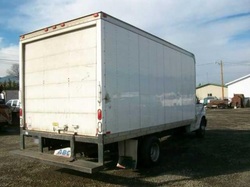
Justin Taylor, whose family business has been refurbishing Airstream trailers into chemically safe homes for two generations, uses powder-coated aluminum for interior walls. It's lightweight, avoids the need for paint, and can create an airtight seal, which allows more leeway with insulation materials. But it's not easy to hang up art, and I'm not sure I want that much metal around me.
One option was to use the cargo portion of a box truck. Some of these are made of aluminum, but I could use a different material for the interior walls. A box truck container is inexpensive, but it limits me to a squared off shape, unless I decide to modify it. Curve in the ceiling adds esthetic value to the interiors, but loses me some interior storage space up in those high corners. More importantly, it ties me to the specific motor and fuel of the vehicle I build on. I also need to think about safety and structural strength. I need the frame of the house to withstand possible collisions or other kinds of damage, so I need both flexibility and sturdiness.
In the end I decided to go with an aluminum frame gooseneck trailer, with an aluminum exterior, lightweight, strong, airtight and chemically inert.
One option was to use the cargo portion of a box truck. Some of these are made of aluminum, but I could use a different material for the interior walls. A box truck container is inexpensive, but it limits me to a squared off shape, unless I decide to modify it. Curve in the ceiling adds esthetic value to the interiors, but loses me some interior storage space up in those high corners. More importantly, it ties me to the specific motor and fuel of the vehicle I build on. I also need to think about safety and structural strength. I need the frame of the house to withstand possible collisions or other kinds of damage, so I need both flexibility and sturdiness.
In the end I decided to go with an aluminum frame gooseneck trailer, with an aluminum exterior, lightweight, strong, airtight and chemically inert.
Sing Core
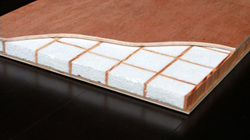
Sing core is an environmentally safe, lightweight and very strong honeycomb panel, made of wood fiber and recycled foam. It can be finished with an outer skin of aluminum, fiberglass or solid wood, and made in varying sizes and thicknesses as needed. It's structurally strong, and can be used in many creative ways, but I ended up deciding to use other materials.
Insulation

Ecovative has developed a "grow in place" insulation that "uses mycelium (mushroom “roots”) to bond together agricultural byproducts like corn stalks into a material that can replace plastic foam." They go on to say, "Mushroom Insulation grows into wood forms over the course of a few days, forming an airtight seal. It dries over the next month (kind of like how concrete cures) and you are left with an airtight wall that is extremely strong. Best yet, it saves on material costs, as you don’t need any studs in the wall, and it gives you great thermal performance since it’s one continuous insulated wall assembly. The finished Mushroom® Insulation is also fire resistant and very environmentally friendly." After a number of conversations, I ended up not choosing them, mostly because it's still experimental, and having them grow special batches for me, on organic agricultural waste would be both costly, and hard to do in the spring, since most agricultural waste becomes available in the fall. It's an exciting material, but closed cell rigid foam insulation that comes covered with foil and is sealed with foil tape, is cheaper, easily obtained, and twice as effective an insulator.
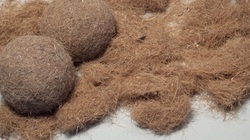
Another option I looked into are Neptune balls. These loose balls of organic matter are made when the action of waves tangles and compresses seaweed and tosses it up onto the beaches of the Mediterranean. The material is fire resistant, doesn't mold or rot and is non-toxic. But all currently available natural insulation is much less effective than foam, and since the type I've chosen is chemically clean and can be well sealed, I am going a more conventional route.
Windows, Skylights, Suntubes
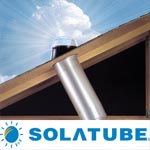
Anywhere that there's an opening in the shell, the issue of leakage becomes important. There are good, non-toxic silicone sealants, but still, each opening increases the risk of unwanted water or fumes penetrating the barrier into my sanctuary.
Because weight is an issue, I've looked at some alternative glazing materials, but I'm not persuaded that they're chemically safe. I think I'll end up trimming ounces elsewhere and stick to well sealed multiple glazed windows. Solar tunnels, or sun tubes, are highly polished aluminum tubes inserted through roofs that channel daylight to a diffuser. They're an excellent source of natural light, equivalent to a strong light bulb, but holes in the roof are still holes in the roof. I like the feeling of security that a solid roof brings, and as I said, I want to reduce the risk of water leakage. I'm going to go with clerestory windows, strips of small panes placed high in the walls, providing natural light without reducing privacy.
Because weight is an issue, I've looked at some alternative glazing materials, but I'm not persuaded that they're chemically safe. I think I'll end up trimming ounces elsewhere and stick to well sealed multiple glazed windows. Solar tunnels, or sun tubes, are highly polished aluminum tubes inserted through roofs that channel daylight to a diffuser. They're an excellent source of natural light, equivalent to a strong light bulb, but holes in the roof are still holes in the roof. I like the feeling of security that a solid roof brings, and as I said, I want to reduce the risk of water leakage. I'm going to go with clerestory windows, strips of small panes placed high in the walls, providing natural light without reducing privacy.
Accessible Entrances and Exits
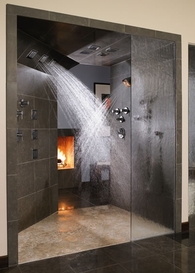
At the moment, what will make my doorway accessible is that it contains a decontamination chamber for shedding outdoor pollution--mine and that of my guests. I can climb steps, but I may not always be able to do so, and many of my friends can't, and I also can't lift heavy loads. This means my doorway must eventually include a power lift, and be wide enough for a standard chair. My entrance will be through a shower/mud room, and I'll have to make sure there's room for a chair to maneuver. I will also have an emergency exit near my bed.